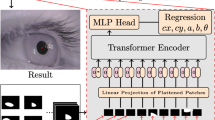Abstract
Biometric applications are very sensitive to the process because of its complexity in presenting unstructured input to the processing. The existing applications of image processing are based on the implementation of different programing segments such as image acquisition, segmentation, extraction, and final output. The proposed model is designed with 2 convolution layers and 3 dense layers. We examined the module with 5 datasets including 3 benchmark datasets, namely CASIA, UBIRIS, MMU, random dataset, and the live video. We calculated the FPR, FNR, Precision, Recall, and accuracy of each dataset. The calculated accuracy of CASIA using the proposed system is 82.8%, for UBIRIS is 86%, MMU is 84%, and the random dataset is 84%. On live video with low resolution, calculated accuracy is 72.4%. The proposed system achieved better accuracy compared to existing state-of-the-art systems.














Similar content being viewed by others
Explore related subjects
Discover the latest articles, news and stories from top researchers in related subjects.References
Daugman J (2003) The importance of being random: statistical principles of iris recognition. Pattern Recogn 36(2):279–291
Daugman J (2009) How iris recognition works. In: The essential guide to image processing, Academic Press, pp 715–739
Boles WW, Boashash B (1998) A human identification technique using images of the iris and wavelet transform. IEEE Trans Signal Process 46(4):1185–1188
Masek L (2003) Matlab source code for a biometric identification system based on iris patterns. http://people.csse.uwa.edu.au/pk/studentprojects/libor/
Jamal I, Akram MU, Tariq A (2012) Retinal image preprocessing: background and noise segmentation. Telkomnika 10(3):537–544
Sharma N, Ray AK, Sharma S, Shukla KK, Pradhan S, Aggarwal LM (2008) Segmentation and classification of medical images using texture-primitive features: application of BAM-type artificial neural network. J Med Phys Assoc Med Phys India 33(3):119
Ma L, Tan T, Wang Y, Zhang D (2003) Personal identification based on iris texture analysis. IEEE Trans Pattern Anal Mach Intell 25(12):1519–1533
Suganthy M, Ramamoorthy P (2012) Principal component analysis based feature extraction, morphological edge detection and localization for fast iris recognition. J Comput Sci 8(9):1428
Najafi M, Ghofrani S (2011) 7 Iris recognition based on using ridgelet and curvelet transform
Radman A, Jumari K, Zainal N (2013) Fast and reliable iris segmentation algorithm. IET Image Proc 7(1):42–49
Tsai H-S, Hung W-L, Yang M-S (212) A robust kernel-based fuzzy c-means algorithm by incorporating suppressed and magnified membership for MRI image segmentation. In: International conference on artificial intelligence and computational intelligence, Springer, Berlin, Heidelberg, pp 744–754
Chinsatit W, Saitoh T (2017) CNN-based pupil center detection for wearable gaze estimation system. Appl Comput Intell Soft Comput 2017
Jan F, Usman I (2014) Iris segmentation for visible wavelength and near infrared eye images. Optik 125(16):4274–4282
Long J, Shelhamer E, Darrell T (2015) Fully convolutional networks for semantic segmentation. In: Proceedings of the IEEE conference on computer vision and pattern recognition, pp 3431–3440
Liu N, Li H, Zhang M, Liu J, Sun Z, Tan T (2016) Accurate iris segmentation in non-cooperative environments using fully convolutional networks. In: 2016 international conference on biometrics (ICB), IEEE, pp 1–8
Ronneberger O, Fischer P, Brox T (2015) U-net: convolutional networks for biomedical image segmentation. In: International conference on medical image computing and computer-assisted intervention. Springer, Cham, pp 234–241
Abbasi A, Khan M (2016) Iris-pupil thickness based method for determining age group of a person. Int Arab J Inf Technol 13(6)
Ahmad S, Fuller B (2018) Unconstrained iris segmentation using convolutional neural networks. In: Asian conference on computer vision, Springer, Cham, pp 450–466
Tobji R, Di W, Ayoub N (2019) FMnet: iris segmentation and recognition by using fully and multi-scale CNN for biometric security. Appl Sci 9(10):2042
Bazrafkan S, Thavalengal S, Corcoran P (2018) An end to end deep neural network for iris segmentation in unconstrained scenarios. Neural Netw 106:79–95
Pathak M, Bairagi V, Srinivasu N. Multimodal eye biometric system based on contour based E-CNN and multi algorithmic feature extraction using SVBF matching
Han SY, Kwon HJ, Kim Y, Cho NI (2020) Noise-robust pupil center detection through CNN-based segmentation with shape-prior loss. IEEE Access 8:64739–64749
Lee YW, Kim KW, Hoang TM, Arsalan M, Park KR (2019) Deep residual CNN-based ocular recognition based on rough pupil detection in the images by NIR camera sensor. Sensors 19(4):842
Pathak M, Srinivasu N, Bairagi V (2019) Effective segmentation of sclera, iris and pupil in noisy eye images. Telkomnika 17(5)
Lozej J, Meden B, Struc V, Peer P (2018) End-to-end iris segmentation using U-Net. In: 2018 IEEE international work conference on bioinspired intelligence (IWOBI), IEEE, pp 1–6
Nguyen K, Fookes C, Ross A, Sridharan S (2017) Iris recognition with off-the-shelf CNN features: a deep learning perspective. IEEE Access 6:18848–18855
Salve SS, Narote SP (2016) Iris recognition using SVM and ANN. In: 2016 international conference on wireless communications, signal processing and networking (WiSPNET), IEEE, pp 474–478
Das A, Pal U, Ballester MAF, Blumenstein M (2014) A new efficient and adaptive sclera recognition system. In: 2014 IEEE symposium on computational intelligence in biometrics and identity management (CIBIM), IEEE, pp 1–8
Li D, Winfield D, Parkhurst DJ (2005) Starburst: a hybrid algorithm for video-based eye tracking combining feature-based and model-based approaches. In: 2005 IEEE computer society conference on computer vision and pattern recognition (CVPR’05)-workshops, IEEE, pp 79–79
Fischler MA, Bolles RC (1981) Random sample consensus: a paradigm for model fitting with applications to image analysis and automated cartography. Commun ACM 24(6):381–395
Fuhl W, Santini T, Kasneci G, Kasneci E (2016) Pupilnet: convolutional neural networks for robust pupil detection. Preprint arXiv:1601.04902
Arsalan M, Hong HG, Naqvi RA, Lee MB, Kim MC, Kim DS, Kim CS, Park KR (2017) Deep learning-based iris segmentation for iris recognition in visible light environment. Symmetry 9(11):263
Author information
Authors and Affiliations
Corresponding author
Additional information
Publisher's Note
Springer Nature remains neutral with regard to jurisdictional claims in published maps and institutional affiliations.
Rights and permissions
About this article
Cite this article
Swathi, A., Aarti & Kumar, S. A smart application to detect pupil for small dataset with low illumination. Innovations Syst Softw Eng 17, 29–43 (2021). https://doi.org/10.1007/s11334-020-00382-3
Received:
Accepted:
Published:
Issue Date:
DOI: https://doi.org/10.1007/s11334-020-00382-3




